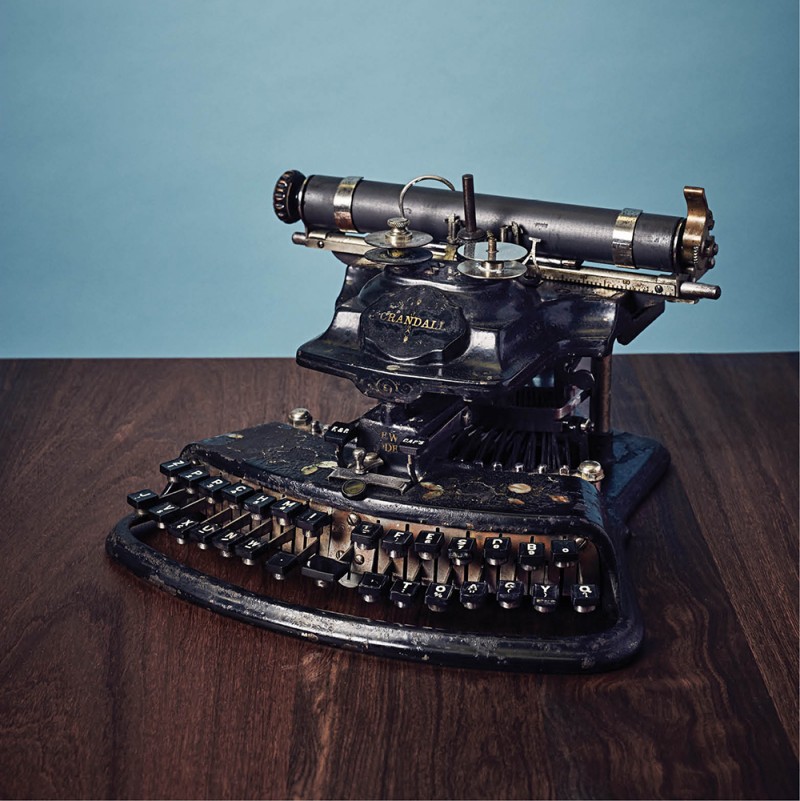It all started with a Remington Noiseless Model 7. Richard Polt was a 12-year-old in Oakland, California, in the 1970s when his dad bought him the classic typewriter at a garage sale. Cut to 1994, when Polt discovered the book American Typewriters: A Collector’s Encyclopedia. On the cover was a wacky 19th-century model called the Crandall, which had a curved two-row keyboard and inlaid mother-of-pearl stylings. “Victorians liked to tart things up,” Polt explains. The weird and wonderful machine triggered a collector’s instinct, and he never looked back.

Photography by Jeremy Kramer

Photograph by Jeremy Kramer
Polt, now a philosophy professor at Xavier University, has about 100 models dating from 1875 to 2012 crammed into his campus office, not to mention untold numbers in his home and gifted throughout the city (including in this writer’s household).

Photograph by Jeremy Kramer
Last year, Polt leveraged 20-odd years of self-taught typewriter expertise and wrote a book: The Typewriter Revolution, a 382-page Valentine to those intriguing, peculiar, and often persnickety machines. The book is one part history, one part owner’s manual, and one part philosophical statement. Polt tracks the evolution of typewriters from the early 19th-century writing machines to the proliferation of the devices leading up to the 20th century and beyond. As he notes in his book, “The decade of the 1890s sported the greatest biodiversity in the typewriter ecosystem. Hundreds of patents were filed and dozens of companies, mostly American, competed for a share of the growing market.” The book gets very inside baseball, as it were, explaining basic tasks and maintenance along with the intricacies of ribbons, inkpads, rollers, cylinders, typebars, carriage returns, and keyboards. (One factoid, among many: The QWERTY keyboard was created by newspaperman and politician Christopher L. Sholes in the 1870s.) And that’s all before the industry went electric.

Photograph by Jeremy Kramer
You may remember Polt’s name from the 2004 presidential election, when 60 Minutes ran a story about then-President Bush’s time in the Air National Guard in the early 1970s. The show had acquired documents allegedly criticizing his service and presented them as authentic evidence. Polt was one of several typewriter and typography experts who discredited the documents, pointing out that they were made by a word processor, a technology that was not available during the time period in question. CBS retracted the story, apologized to viewers, and host Dan Rather was eventually forced to retire.

Photograph by Jeremy Kramer
Political intrigue aside, Polt sees typewriters as more than an anachronistic hobby. They represent a rejection of the contemporary digital landscape (or hellscape, depending on your relationship to Pinterest). Typewriters are the opposite of iPhones: There’s no multitasking, no data streaming, no mindless viewing—and no creepy surveillance. Polt’s opening “Typewriter Manifesto” uses resistance-style language (“We assert our right to resist the Paradigm, to rebel against the Information Regime, to escape the Data Stream…”); he and his insurgency value “the real over representation, the physical over the digital, the durable over the unsustainable, and the self-sufficient over the efficient.” The Typewriter Revolution is both a playful and deadly serious takedown of the digital world’s omnipresence.
But Polt also just loves typewriters, in all their quirky loveliness. And as for his collection? “The quest never ends,” he says.
Click through our gallery to see more of Polt’s beloved writing machines:












Facebook Comments